Mi Pueblo Bonito Mural
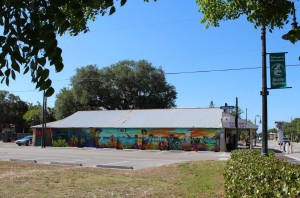 Mi Pueblo Bonito is the first mural in the City of Bonita Springs new Art in the Sun Along Old 41 mural initiative. Rendered by Cuban-born artist Alejandro Nunez, My Beautiful Town’s five tightly-rendered content-intensive 8-foot-tall by 8-foot-wide exterior panels span centuries of local history, making the north exterior wall not only a vibrant artistic landmark but a local gathering spot for residents, visitors and area schoolchildren.
Mi Pueblo Bonito is the first mural in the City of Bonita Springs new Art in the Sun Along Old 41 mural initiative. Rendered by Cuban-born artist Alejandro Nunez, My Beautiful Town’s five tightly-rendered content-intensive 8-foot-tall by 8-foot-wide exterior panels span centuries of local history, making the north exterior wall not only a vibrant artistic landmark but a local gathering spot for residents, visitors and area schoolchildren.
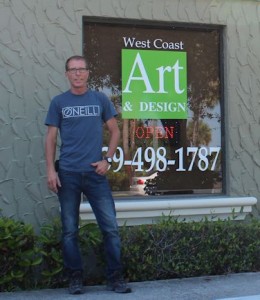 Nunez was amazed by how much attention he attracted during the time he was completing the project. “It was a great experience,” Nunez says, and it began from the moment he started the first panel. “Locals, tourists, Spanish, English, came, stopped, took pictures and spent lots of time asking questions and just chatting with me.” Some came on foot; others by bicycle and car. A school bus driver even stopped with a bus load of kids. All were thrilled. A couple even claimed it was the best thing to happen in Bonita Springs in the last ten years, a sentiment echoed by Benson’s Grocery owner Harshil Patel. “People drive out just to see it. While they’re here, they shop inside the store, so the mural has been good for business.”
Nunez was amazed by how much attention he attracted during the time he was completing the project. “It was a great experience,” Nunez says, and it began from the moment he started the first panel. “Locals, tourists, Spanish, English, came, stopped, took pictures and spent lots of time asking questions and just chatting with me.” Some came on foot; others by bicycle and car. A school bus driver even stopped with a bus load of kids. All were thrilled. A couple even claimed it was the best thing to happen in Bonita Springs in the last ten years, a sentiment echoed by Benson’s Grocery owner Harshil Patel. “People drive out just to see it. While they’re here, they shop inside the store, so the mural has been good for business.”
“I’m glad to have had the opportunity to do something that brings so much happiness to this town,” Nunez comments humbly.
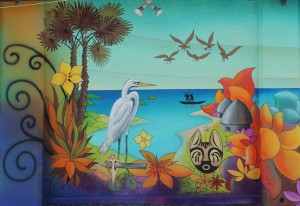 The mural’s first panel features imagery from the area’s indigenous people, the Calusa, who reigned supreme in Southwest Florida from 1150 B.C. to roughly 1750. In fact, by the time Ponce de Leon discovered Florida in 1513, the Calusa nation consisted of 20,000 people living in more than 50 villages extending from Charlotte Harbor to the north, Lake Okeechobee to the east and the Florida
The mural’s first panel features imagery from the area’s indigenous people, the Calusa, who reigned supreme in Southwest Florida from 1150 B.C. to roughly 1750. In fact, by the time Ponce de Leon discovered Florida in 1513, the Calusa nation consisted of 20,000 people living in more than 50 villages extending from Charlotte Harbor to the north, Lake Okeechobee to the east and the Florida 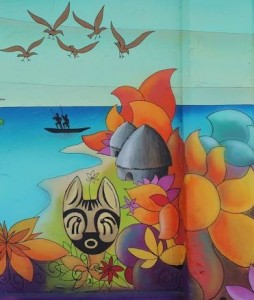 Keys to the south, with the nation’s capital on Mound Key in nearby Estero Bay. “To do this part of the mural, I researched the tools they used, masks they wore during ceremonies and the types of houses they built and lived in,” notes Nunez. This iconography is interspersed among brightly-colored flowers and tropical plants that are set against a backdrop of cerulean sky and the deep blue waters fished and travelled by the Calusa, who characteristically made their settlements along the water’s edge.
Keys to the south, with the nation’s capital on Mound Key in nearby Estero Bay. “To do this part of the mural, I researched the tools they used, masks they wore during ceremonies and the types of houses they built and lived in,” notes Nunez. This iconography is interspersed among brightly-colored flowers and tropical plants that are set against a backdrop of cerulean sky and the deep blue waters fished and travelled by the Calusa, who characteristically made their settlements along the water’s edge.
The second panel depicts animals native to Southwest Florida, including playful porpoises, sea turtles, 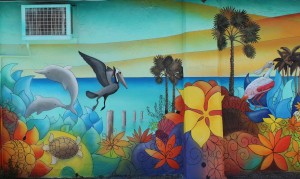 spoonbill and a landing pelican, with heron, seagulls, an alligator and manatee spilling over from and into the other three panels. Once again, Nunez intermingles his wildlife images among the gaily colored flowers and tropical plants and frames them against the blue waters and striated skies that serve to unify the panels into a cohesive whole.
spoonbill and a landing pelican, with heron, seagulls, an alligator and manatee spilling over from and into the other three panels. Once again, Nunez intermingles his wildlife images among the gaily colored flowers and tropical plants and frames them against the blue waters and striated skies that serve to unify the panels into a cohesive whole.
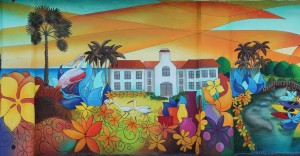 In the mural’s third and fourth panels, Nunez includes examples some of the architecture and historic buildings that are commonly associated with Old Bonita. This is where viewers will find the 25-room Shangri-La Springs Hotel that Harvie Heitman’s family built in 1921 in the heart of Old Bonita,
In the mural’s third and fourth panels, Nunez includes examples some of the architecture and historic buildings that are commonly associated with Old Bonita. This is where viewers will find the 25-room Shangri-La Springs Hotel that Harvie Heitman’s family built in 1921 in the heart of Old Bonita, 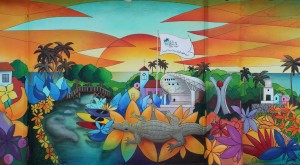 pots that signify the old pottery barn that stands at the entrance to Old 41, and the 1940s Isadorah Hermann Water Tank along with more modern iterations such as the Riverside Park bandshell, the Florida Gulf Coast University artist studios and Away, the 12 foot tall, 800 pound, stainless steel sculpture by Massachusetts sculptor Dale Rogers that the City of Bonita Springs added to its public art collection in 2011. Nunez even included a banner that incorporates the City’s new motto, “Small town charm, big bright future.”
pots that signify the old pottery barn that stands at the entrance to Old 41, and the 1940s Isadorah Hermann Water Tank along with more modern iterations such as the Riverside Park bandshell, the Florida Gulf Coast University artist studios and Away, the 12 foot tall, 800 pound, stainless steel sculpture by Massachusetts sculptor Dale Rogers that the City of Bonita Springs added to its public art collection in 2011. Nunez even included a banner that incorporates the City’s new motto, “Small town charm, big bright future.”
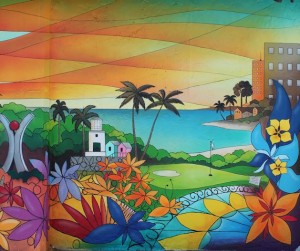 The fifth and final panel ends with golf courses and high rises that form, perhaps, a bridge to Bonita’s future.
The fifth and final panel ends with golf courses and high rises that form, perhaps, a bridge to Bonita’s future.
With its Art Deco and colorful graphic style, Mi Pueblo Bonito reflects place-making at its very best. In the short time since its completion in March of 2014, the mural has already served to boost/strengthen civic pride; enhance and define the city’s identity; reflect the unique character and history of the city; 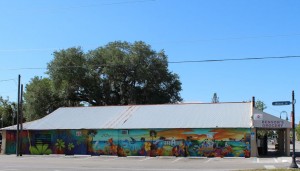 burnish the Bonita Springs’ image to the outside world; create an important positive impression for visitors; and encourage and increase tourism.
burnish the Bonita Springs’ image to the outside world; create an important positive impression for visitors; and encourage and increase tourism.
On May 7, 2014, the artist presented a certificate of dedication for the mural to the mayor and city council, as well as all citizens of Bonita Springs, and the City presented to the artist its certificate of appreciation in recognition of Nunez’s exceptional dedication to the Mi Pueblo Bonito, the first mural of the “Art in the Sun Along Old 41″ public art initiative.
How Nunez Made It
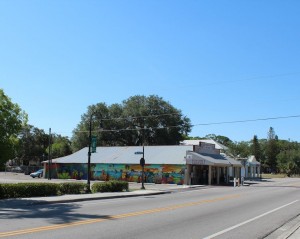 Nunez’s involvement with the mural project started when he spied a call to artists that the Bonita Springs Art in Public Places Board published in the local newspaper. “One of my mural patrons also saw it and mentioned the opportunity to me,” Alex adds. “So I sent my resume to the APPB, submitted a design, and they picked me for the project.”
Nunez’s involvement with the mural project started when he spied a call to artists that the Bonita Springs Art in Public Places Board published in the local newspaper. “One of my mural patrons also saw it and mentioned the opportunity to me,” Alex adds. “So I sent my resume to the APPB, submitted a design, and they picked me for the project.”
The Board contacted Harshil Patel, who owns Benson’s Grocery Store on Old U.S. 41 and Wilson Street. “The City called out of the blue,” recalls Patel, who readily accepted the City’s overtures.
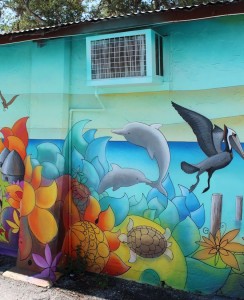 Nunez spent four to six hours a day for more than a month working on the mural. But the mural entailed a great deal more than painting the imagery that is visible to the eye.
Nunez spent four to six hours a day for more than a month working on the mural. But the mural entailed a great deal more than painting the imagery that is visible to the eye.
Before he get started, Nunez first had to prepare Benson’s exterior wall for the paint. That turned out to be a prodigious and time-consuming undertaking. After power washing the surface, Alex found that he had to patch holes, build chases to cover exterior exterior pipes and electrical conduit, and construct a drain to take care of the condensate dripping from the air-conditioning unit mounted to the wall toward the back of the unit.
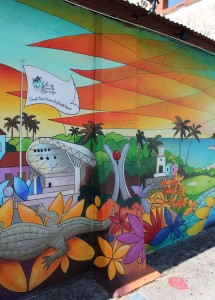 Nunez credits the time he spent doing faux finishes in Costa Rica, Miami and here in Bonita Springs with giving him the knowledge of materials and applicable building codes he needed in order to carry out the Mi Pueblo Bonito mural project. It also provided him with the experience to tackle challenging architectural elements like the half dozen vertical concrete block columns that he had to seamlessly incorporate into the execution of the design notwithstanding the fact that they protruded several inches from the otherwise two-dimensional painting surface presented by the rest of the wall.
Nunez credits the time he spent doing faux finishes in Costa Rica, Miami and here in Bonita Springs with giving him the knowledge of materials and applicable building codes he needed in order to carry out the Mi Pueblo Bonito mural project. It also provided him with the experience to tackle challenging architectural elements like the half dozen vertical concrete block columns that he had to seamlessly incorporate into the execution of the design notwithstanding the fact that they protruded several inches from the otherwise two-dimensional painting surface presented by the rest of the wall.
Once the stucco cured, Nunez then applied two coats of Hi Build primer. 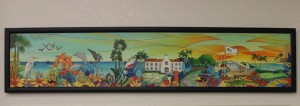 As he researched Bonita history, Nunez sketched the mural on paper, and as soon as the primer dried, he transferred the sketch to the grocery store wall using a Sharpie so that his lines would not blur or disappear as he applied pigment. The paint he used was a combination of top-of-the-line exterior wall paint
As he researched Bonita history, Nunez sketched the mural on paper, and as soon as the primer dried, he transferred the sketch to the grocery store wall using a Sharpie so that his lines would not blur or disappear as he applied pigment. The paint he used was a combination of top-of-the-line exterior wall paint 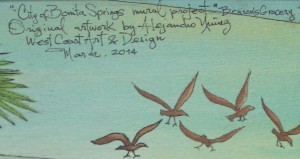 (Sherwin Williams’ Resilience acrylic latex paint) and water-based art pigments “which breathe, making them flexible.” A layer of sealant was applied to lock in the color and a top coat with a UV-protectant keeps the color from fading in the intense Florida sunlight.
(Sherwin Williams’ Resilience acrylic latex paint) and water-based art pigments “which breathe, making them flexible.” A layer of sealant was applied to lock in the color and a top coat with a UV-protectant keeps the color from fading in the intense Florida sunlight.
The budget for the entire mural was a scant $8,000, and that included not only the mural’s design and painting, but all the site site prep described above.
About Art in the Sun Along Old 41’s Public-Private Mural Initiative
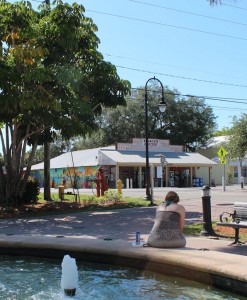 Art in the Sun Along Old 41 started as a means of acquiring outdoor sculpture in the downtown Bonita Springs historic district, but in 2014, the program morphed into a mural initiative that launched with Alex Nunez’s Mi Pueblo Bonito (My Beautiful Town) on the north wall of Benson’s Grocery. Going forward, Bonita’s Art in Public Places Board envisions the mural component of Art in the Sun Along Old 41 as an ongoing, interactive public-private partnership in which business property owners make available one of their exterior walls, commissioned artists prepare the site and do the rendering, and the City provides the budget to cover the work.
Art in the Sun Along Old 41 started as a means of acquiring outdoor sculpture in the downtown Bonita Springs historic district, but in 2014, the program morphed into a mural initiative that launched with Alex Nunez’s Mi Pueblo Bonito (My Beautiful Town) on the north wall of Benson’s Grocery. Going forward, Bonita’s Art in Public Places Board envisions the mural component of Art in the Sun Along Old 41 as an ongoing, interactive public-private partnership in which business property owners make available one of their exterior walls, commissioned artists prepare the site and do the rendering, and the City provides the budget to cover the work.
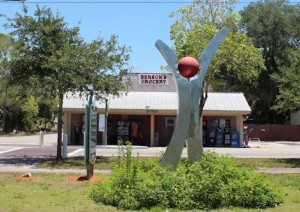 By agreement, the guaranteed life of each mural is just three years. After that, the property owner has the right to remove the mural, replace it with another one or enter into an agreement with the artist to maintain it awhile longer. “No business property owner would ever agree to host a mural if they had to maintain it in perpetuity,” notes APPB Chairman Nigel Fullick. Especially since City-
By agreement, the guaranteed life of each mural is just three years. After that, the property owner has the right to remove the mural, replace it with another one or enter into an agreement with the artist to maintain it awhile longer. “No business property owner would ever agree to host a mural if they had to maintain it in perpetuity,” notes APPB Chairman Nigel Fullick. Especially since City-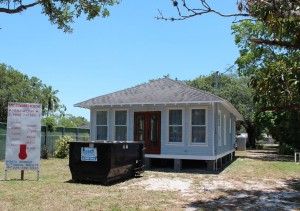 funded façade enhancements, landscaping incentives, centralized stormwater facilities and additional on-street parking are likely to induce property owners in Old Bonita to renovate, add on to, or raze and rebuild in order to take full advantage of the new densities that will be allowed on their sites. In fact, the mural initiative is being coordinated by the APPB with the planned $16 million revitalization of downtown Bonita, which also includes beautification of medians, sidewalks and other pedestrian pathways.
funded façade enhancements, landscaping incentives, centralized stormwater facilities and additional on-street parking are likely to induce property owners in Old Bonita to renovate, add on to, or raze and rebuild in order to take full advantage of the new densities that will be allowed on their sites. In fact, the mural initiative is being coordinated by the APPB with the planned $16 million revitalization of downtown Bonita, which also includes beautification of medians, sidewalks and other pedestrian pathways.
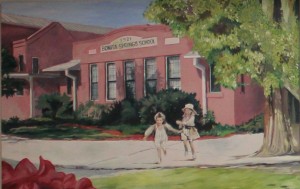 Up to four more murals are contemplated over the next couple of years. In fact, the APPB has already sent two more concept drawings to City Council for their approval. “After that, the Board may step back and re-evaluate the program,” states Fullick. Meanwhile, the APPB will continue to explore other ways to partner with property and business owners, artists and the general public to bring more art to the community.
Up to four more murals are contemplated over the next couple of years. In fact, the APPB has already sent two more concept drawings to City Council for their approval. “After that, the Board may step back and re-evaluate the program,” states Fullick. Meanwhile, the APPB will continue to explore other ways to partner with property and business owners, artists and the general public to bring more art to the community. 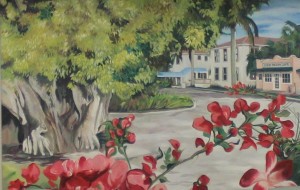 “We are working with [Executive Director] Susan Bridges and the Center for the Arts of Bonita Springs to identify prospective artists and bring exhibitions to town which could coincide with Celebrate Bonita, the Bonita Blues Festival and the tri-annual Bonita Springs National Art Festival,” states Director of Development Services Arleen M. Hunter. The goal is to host something annually between February and April that could lead to cost-effective, quality additions to the city’s public art collection.
“We are working with [Executive Director] Susan Bridges and the Center for the Arts of Bonita Springs to identify prospective artists and bring exhibitions to town which could coincide with Celebrate Bonita, the Bonita Blues Festival and the tri-annual Bonita Springs National Art Festival,” states Director of Development Services Arleen M. Hunter. The goal is to host something annually between February and April that could lead to cost-effective, quality additions to the city’s public art collection.
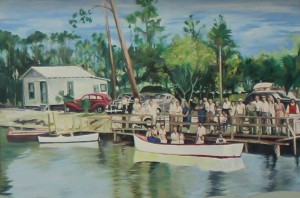 All these efforts belie a conviction on the part of the City and APPB that public art improves the quality of life in the community, enhances the reputation of its citizens and the town, educates the public about and exposes people to art and culture. It has not escaped anyone from the mayor on down to the APPB that a common denominator possessed by thriving, robust downtowns across the country is their vital public art programs.
All these efforts belie a conviction on the part of the City and APPB that public art improves the quality of life in the community, enhances the reputation of its citizens and the town, educates the public about and exposes people to art and culture. It has not escaped anyone from the mayor on down to the APPB that a common denominator possessed by thriving, robust downtowns across the country is their vital public art programs. 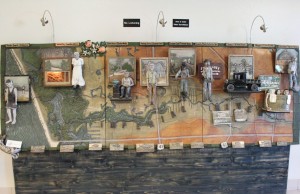 “It’s economic development 101,” maintains Coucilwoman Janet Martin. “We want Bonita Springs to be known for art and culture,” Ms. Hunter emphatically adds. “We’re proud of the Center for the Arts. We’re proud of the fact that Bonita National is consistently ranked as one of the top 10 outdoor art festivals in the country. We’re committed to the Arts in Bonita Springs.”
“It’s economic development 101,” maintains Coucilwoman Janet Martin. “We want Bonita Springs to be known for art and culture,” Ms. Hunter emphatically adds. “We’re proud of the Center for the Arts. We’re proud of the fact that Bonita National is consistently ranked as one of the top 10 outdoor art festivals in the country. We’re committed to the Arts in Bonita Springs.”
About Alejandro Nunez
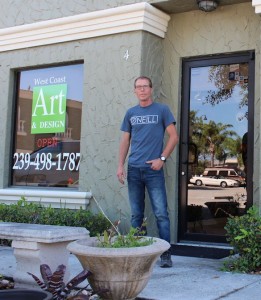 Alejandro “Alex” Nunez is a Cuban-born graphic designer.
Alejandro “Alex” Nunez is a Cuban-born graphic designer.
Nunez was born in Havana in 1963. He was interested in art from an early age, Nunez reports, recalling the time he drew a kite across his parents’ freshly painted white wall with his colored pencils.
He attended the Art Academy in Havana, graduating from the Technical Institute of Design in 1990 as a graphic designer. Admission is not automatic. “To get in,” Nunez points out, “you must first pass a test.”
After graduation, Alex worked as a graphic designer for the National Institute of Tourism, an influence that informs both his murals and fine art to this day.
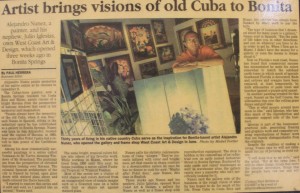 Five years later, Nunez left Cuba for Costa Rica where he met, fell in love with and married his wife Maria Abela, with whom he shares a daughter. “Maria comes from the family of one of Cuba’s most iconic artists,” Alex adds. In Costa Rica, Alex started his own graphic design business, creating commercial murals and faux finishes as well.
Five years later, Nunez left Cuba for Costa Rica where he met, fell in love with and married his wife Maria Abela, with whom he shares a daughter. “Maria comes from the family of one of Cuba’s most iconic artists,” Alex adds. In Costa Rica, Alex started his own graphic design business, creating commercial murals and faux finishes as well.
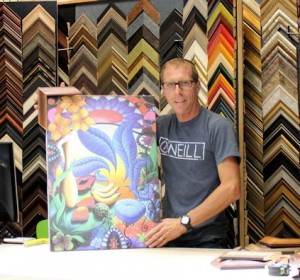 In 1999, Alejandro and Maria moved to the United States “to be closer to family.” They landed in Miami, where Nunez went to work for Cigars and Things, a Cuban memorabilia and art gallery. There, he acquired skills in custom art framing and embarked upon a series of paintings he titled Ventanas de Mi Tierra, which translates as Windows of My Homeland. The series consists of paintings rendered from the perspective of the elevated Havana balconies that overlook the Spanish Colonial architecture of the city. Nunez admits to the paintings being both nostalgic and romantic, conjuring memories of old Cuba during a time when it was still free (although, ironically, Alex never knew that freedom personally, having been born four years after Fidel Castro seized control of the island nation).
In 1999, Alejandro and Maria moved to the United States “to be closer to family.” They landed in Miami, where Nunez went to work for Cigars and Things, a Cuban memorabilia and art gallery. There, he acquired skills in custom art framing and embarked upon a series of paintings he titled Ventanas de Mi Tierra, which translates as Windows of My Homeland. The series consists of paintings rendered from the perspective of the elevated Havana balconies that overlook the Spanish Colonial architecture of the city. Nunez admits to the paintings being both nostalgic and romantic, conjuring memories of old Cuba during a time when it was still free (although, ironically, Alex never knew that freedom personally, having been born four years after Fidel Castro seized control of the island nation).
Three years later, Alex and Maria came to Bonita Springs, purchased a home and opened West Coast Art & Design, now located at 24951 Old 41 Rd. For the past decade, the custom framing and artwork shop has served as the springboard for the faux finishing business that informs both the murals Nunez has done not only for the City of Bonita Springs, but forAngelina’s Ristorante and a number of private residences.
Calusa Historic Sites and Attractions
Several area attractions are dedicated to presenting the Calusa history and culture to residents and tourists, including:
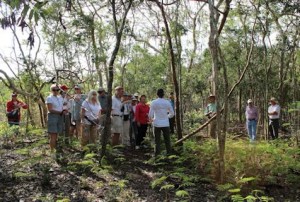 Mound Key Archaeological State Park in Estero Bay near the mouth of the Estero River. Accessible only by boat, this site contains a number of Calusa mounds and shell, fish bone and pottery middens that soar 30 feet above the waters of the bay. Once the capital of the Calusa nation, Mound Key possessed an intricate network of tribal and ceremonial mounds, water courts and canals designed to impress visitors with the power of the Calusa’s supreme chief and the accomplishments of the Calusa people. Mound Key is accessible by water from Koreshan State Historic Site, which is located at 3800 Corkscrew Road, Estero. For more information, please telephone 239-992-0311 or visit www.floridastateparks.org/MoundKey.
Mound Key Archaeological State Park in Estero Bay near the mouth of the Estero River. Accessible only by boat, this site contains a number of Calusa mounds and shell, fish bone and pottery middens that soar 30 feet above the waters of the bay. Once the capital of the Calusa nation, Mound Key possessed an intricate network of tribal and ceremonial mounds, water courts and canals designed to impress visitors with the power of the Calusa’s supreme chief and the accomplishments of the Calusa people. Mound Key is accessible by water from Koreshan State Historic Site, which is located at 3800 Corkscrew Road, Estero. For more information, please telephone 239-992-0311 or visit www.floridastateparks.org/MoundKey.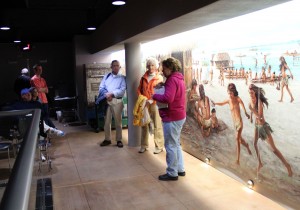 Mound House (also known as the Fort Myers Cultural Museum and Environmental Learning Center) on Fort Myers Beach (Estero Island). This site contains an excavated Calusa mound as well as a mural painted by a team that included artist Merald Clark, who did the original drawing, Kevin Thomas of Synergy Design Group, who provided the digital painting, and
Mound House (also known as the Fort Myers Cultural Museum and Environmental Learning Center) on Fort Myers Beach (Estero Island). This site contains an excavated Calusa mound as well as a mural painted by a team that included artist Merald Clark, who did the original drawing, Kevin Thomas of Synergy Design Group, who provided the digital painting, and 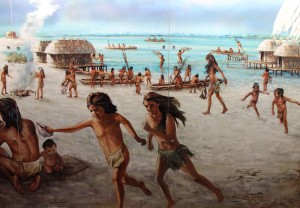 Color Reflections, which was responsible for the printing and installation. Clark read the memoirs of Hernando de Escalante Fontaneda in order to learn first-hand what the Calusa wore, how they built their structures, what and how they cooked, and how they constructed their society. (Fontaneda lived among the Calusa for 18 years after being shipwrecked at the age of 13.) Mound House is located at 289 Connecticut Street, Fort Myers Beach. For more information, please call 239-765-0865 or visit www.moundhouse.org.
Color Reflections, which was responsible for the printing and installation. Clark read the memoirs of Hernando de Escalante Fontaneda in order to learn first-hand what the Calusa wore, how they built their structures, what and how they cooked, and how they constructed their society. (Fontaneda lived among the Calusa for 18 years after being shipwrecked at the age of 13.) Mound House is located at 289 Connecticut Street, Fort Myers Beach. For more information, please call 239-765-0865 or visit www.moundhouse.org.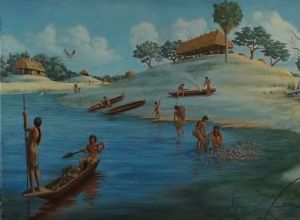 The J. N. “Ding” Darling National Wildlife Refuge on Sanibel Island. Inside this 6,400 acre preserve, is Shell Mound Trail, a 1/4-mile, universally-accessible, interpretive boardwalk that originates near the end of Wildlife Drive. The Trail meanders through a hardwood hammock that has grown on top of an ancient Calusa Indian Shell Mound. Hikers learn about the ancient Calusa as well as the unique hammock environment from interpretive panels located strategically along the path.
The J. N. “Ding” Darling National Wildlife Refuge on Sanibel Island. Inside this 6,400 acre preserve, is Shell Mound Trail, a 1/4-mile, universally-accessible, interpretive boardwalk that originates near the end of Wildlife Drive. The Trail meanders through a hardwood hammock that has grown on top of an ancient Calusa Indian Shell Mound. Hikers learn about the ancient Calusa as well as the unique hammock environment from interpretive panels located strategically along the path.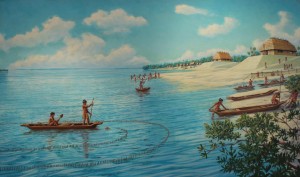 Randell Research Center at Pineland on Pine Island. For more than 1,500 years, the Calusa occupied this 200-acre, internationally-significant archaeological site, leaving behind enormous shell mounds, remnants of an ancient canal and artifacts of daily life. The center allows both a walking tour of the Pineland site and a kayak trip to Josslyn Island, offering informed insight to the archaeology, history and culture of the Calusas. The Calusa Heritage Trail at Randell is a 3,700-foot interpretive walkway that leads visitors through the mounds, canals, and other features of the Pineland archaeological site. Signs along the trail provide visitors with detailed information regarding the Calusa Indians. The trail also features observation platforms atop the site’s tallest shell mound. Calusa Heritage Trail at Pineland is located at 13810 Waterfront Drive, Pineland. For more information, please telephone 239-283-2062 or visit www.flmnh.ufl.edu/rrc/.
Randell Research Center at Pineland on Pine Island. For more than 1,500 years, the Calusa occupied this 200-acre, internationally-significant archaeological site, leaving behind enormous shell mounds, remnants of an ancient canal and artifacts of daily life. The center allows both a walking tour of the Pineland site and a kayak trip to Josslyn Island, offering informed insight to the archaeology, history and culture of the Calusas. The Calusa Heritage Trail at Randell is a 3,700-foot interpretive walkway that leads visitors through the mounds, canals, and other features of the Pineland archaeological site. Signs along the trail provide visitors with detailed information regarding the Calusa Indians. The trail also features observation platforms atop the site’s tallest shell mound. Calusa Heritage Trail at Pineland is located at 13810 Waterfront Drive, Pineland. For more information, please telephone 239-283-2062 or visit www.flmnh.ufl.edu/rrc/.
Shangri-La Springs Hotel
 One of the images that Alex Nunez featured in Mi Pueblo Bonito mural is the Shangri-La Springs Hotel. The Spanish Mission-style hotel was built in 1921 by the family of Fort Myers merchant, banker and developer Harvie Heitman on 8.1 acres of land in the heart of what is now Old Bonita. The family was developing property to the west and the 25-room Heitman Hotel provided potential buyers a place to stay while their new homes were constructed. The natural spring for which the town is named is located on the grounds and flows into Oak Creek.
One of the images that Alex Nunez featured in Mi Pueblo Bonito mural is the Shangri-La Springs Hotel. The Spanish Mission-style hotel was built in 1921 by the family of Fort Myers merchant, banker and developer Harvie Heitman on 8.1 acres of land in the heart of what is now Old Bonita. The family was developing property to the west and the 25-room Heitman Hotel provided potential buyers a place to stay while their new homes were constructed. The natural spring for which the town is named is located on the grounds and flows into Oak Creek.
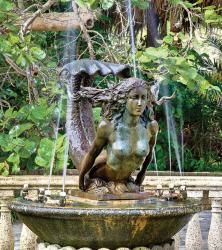 The Depression brought hard times and the hotel was sold to the Haverfields and later to Walter Mach of the Cadillac family, who did elaborate remodeling, expanded the hotel to 50 rooms, and renamed it Villa Bonita. After that, the hotel was acquired by Dr. Charles Gnau, an osteopath interested in the health benefits of the mineral water from the springs. He added a spring-fed pool complete with a statue called the Indian Maiden of the Springs. The spring is reputed to be the first healing spring in North America. (The next closest minerals springs spa is in North Port, north of Punta Gorda in Charlotte County.)
The Depression brought hard times and the hotel was sold to the Haverfields and later to Walter Mach of the Cadillac family, who did elaborate remodeling, expanded the hotel to 50 rooms, and renamed it Villa Bonita. After that, the hotel was acquired by Dr. Charles Gnau, an osteopath interested in the health benefits of the mineral water from the springs. He added a spring-fed pool complete with a statue called the Indian Maiden of the Springs. The spring is reputed to be the first healing spring in North America. (The next closest minerals springs spa is in North Port, north of Punta Gorda in Charlotte County.)
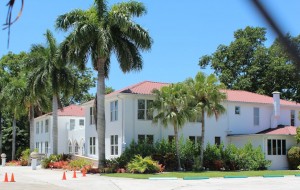 In 1964, R.J. Cheatham purchased the property. Cheatham was also interested in health practice, particularly natural hygiene. He obtained diplomas in Naturopathy, Homeopathic Medicine, Osteopathy Life Science and Metaphysics. He improved the eight acres of ground to provide places for recreation and points of interest conducive to peace of mind and called the health spa, Shangri La.
In 1964, R.J. Cheatham purchased the property. Cheatham was also interested in health practice, particularly natural hygiene. He obtained diplomas in Naturopathy, Homeopathic Medicine, Osteopathy Life Science and Metaphysics. He improved the eight acres of ground to provide places for recreation and points of interest conducive to peace of mind and called the health spa, Shangri La.
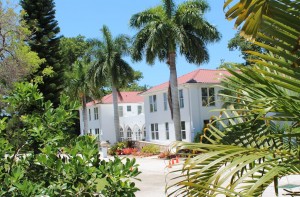 In 1993, Leo Dahlman bought the property with the goal of developing Shangri La into a first class health resort. With a background in historic restoration and hotel management, he restored much of the property to its original grandeur. When the property fell into foreclosure and became available for purchase in 1998, conservationists Addison Fischer and Heather Burch acquired the property through the
In 1993, Leo Dahlman bought the property with the goal of developing Shangri La into a first class health resort. With a background in historic restoration and hotel management, he restored much of the property to its original grandeur. When the property fell into foreclosure and became available for purchase in 1998, conservationists Addison Fischer and Heather Burch acquired the property through the 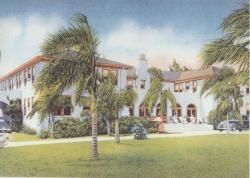 Lama Hana Land Trust, to protect the integrity of this important landmark in Bonita Springs. “In Europe, they have long tradition of spas being developed alongside natural springs,” says current co-owner Heather Burch. “Europeans visited these spas to rest or recuperate.”
Lama Hana Land Trust, to protect the integrity of this important landmark in Bonita Springs. “In Europe, they have long tradition of spas being developed alongside natural springs,” says current co-owner Heather Burch. “Europeans visited these spas to rest or recuperate.”
Among the hotel and spa’s many visitors were Babe Ruth and Buddy Hackett. “There’s neat artwork in Bonita City Hall that includes a spa with Babe Ruth, Buddy Hackett and others,” says renowned historical preservationist J. Allison DeFoor, who once served as former Gov. Jeb Bush’s “Everglades Czar.”
The Isadorah Hermann Water Tank
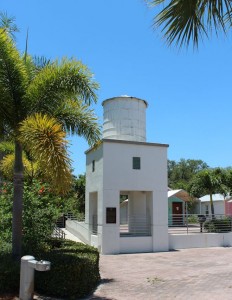 Another of the images contained in the Mi Pueblo Bonito mural is the 1940s Isadorah Hermann Water Tank. The water tank was originally used to store water taken out of a well at the house of Isadorah Hermann at the northwest corner of Old U.S. 41 and Bonita Beach Road. It was moved in 1988 to the ball field in Riverside Park where the band shell now sits and relocated to its present location in 2006 in order to preserve this piece of Bonita Springs history. Although similar towers were common along the Imperial River, the Isadorah Hermann tower is one of only two such towers remaining in existence today. [The artists’ studios used by FGCU students can be seen in the plaza behind the water tower.]
Another of the images contained in the Mi Pueblo Bonito mural is the 1940s Isadorah Hermann Water Tank. The water tank was originally used to store water taken out of a well at the house of Isadorah Hermann at the northwest corner of Old U.S. 41 and Bonita Beach Road. It was moved in 1988 to the ball field in Riverside Park where the band shell now sits and relocated to its present location in 2006 in order to preserve this piece of Bonita Springs history. Although similar towers were common along the Imperial River, the Isadorah Hermann tower is one of only two such towers remaining in existence today. [The artists’ studios used by FGCU students can be seen in the plaza behind the water tower.]














 Tom Hall is both an amateur artist and aspiring novelist who writes art quest thrillers. He is in the final stages of completing his debut novel titled "Art Detective," a story that fictionalizes the discovery of the fabled billion-dollar Impressionist collection of Parisian art dealer Josse Bernheim-Jeune, thought by many to have perished during World War II when the collection's hiding place, Castle de Rastignac in southern France, was destroyed by the Wehrmacht in reprisal for attacks made by members of the Resistance operating in the area. A former tax attorney, Tom holds a bachelor's degree as well as both a juris doctorate and masters of laws in taxation from the University of Florida. Tom lives in Estero, Florida with his fiancee, Connie, and their four cats.
Tom Hall is both an amateur artist and aspiring novelist who writes art quest thrillers. He is in the final stages of completing his debut novel titled "Art Detective," a story that fictionalizes the discovery of the fabled billion-dollar Impressionist collection of Parisian art dealer Josse Bernheim-Jeune, thought by many to have perished during World War II when the collection's hiding place, Castle de Rastignac in southern France, was destroyed by the Wehrmacht in reprisal for attacks made by members of the Resistance operating in the area. A former tax attorney, Tom holds a bachelor's degree as well as both a juris doctorate and masters of laws in taxation from the University of Florida. Tom lives in Estero, Florida with his fiancee, Connie, and their four cats.